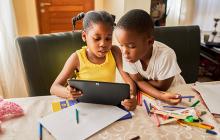Four Perspectives on Helping All Students Thrive

Launched in 2021, the Equity Initiative aims to make a substantive improvement in the lives of students, workers, and communities.
View a recording of the full event.
Learn more about the AIR Equity Initiative and our previous events.
How has the COVID-19 pandemic affected education and what evidence-based strategies can help students thrive now and in the future?
At an AIR Equity Initiative roundtable on May 25, 2022, AIR Board of Directors Vice Chair Lawrence Bobo moderated a panel of four experts representing different aspects of the educational system. They highlighted persistent challenges that arose during the pandemic—or were exacerbated by it—as well as policy and practice innovations that helped practitioners to respond. A common thread across their remarks was the need for deeper engagement of communities in addressing the challenges facing the education system.
In addition to a robust Q&A discussion, each panelist shared a distinctive takeaway based on their experience addressing issues of equity in education—removing barriers and promoting opportunities for student success.
Students Need Credible Messengers
Kameryn Point, a policy & programs associate at the American Youth Policy Forum, emphasized the importance of students’ access to “credible messengers,” individuals to whom they can personally relate. Students are eager for mentors who come from their communities; share their backgrounds, cultures, and languages; and understand their experiences. Point noted that credible messengers must be actively recruited, supported, and valued, including payment for their expertise and time, and coaching for their professional development.
Point’s work with the American Youth Policy Forum’s Youth Policy Consultants, as well as her experience as a former teacher, suggests that intentionally facilitating these kinds of relationships could improve student motivation and engagement and increase their sense of belonging, especially in under-resourced schools and communities. Students also should be seen as experts, Point said, noting that student voices are important in discussions about how to move education forward.
Social and Emotional Learning is More Essential than Ever
When AIR launched the National Survey of Public Education’s Response to COVID-19, the goal of the project was to better understand the impact of the pandemic on student experiences across the country, said Michael Garet, who led the project. He and the survey team found a wide range of student experiences, based on differences in state and local policies, as well as variation in each school district’s capacities and resources. But one common thread was the importance of social and emotional learning.
On the whole, low-poverty districts had more staff trained in and available to provide services related to social and emotional learning, safety and well-being, mental health and wellness, and trauma-informed care. However, even well-resourced schools often fell short in meeting their students’ needs in these areas. Only with specific, deliberate planning and investment were schools and districts well-positioned to respond and adapt to ever-shifting circumstances during the pandemic. Similarly, technology was essential for many districts in supporting communication among teachers, parents, and students, but it was most successfully used in schools that had taken the long view—where teachers had already received technical training prior to the pandemic and students had already received their devices.
The Aftermath of the Pandemic Requires Both Urgency and Flexibility
- Credible messengers from the community can help students engage in learning.
- District leadership must invest in quality teacher training and infrastructure to accelerate student learning.
- Adequate resources and improved instruction for students will increase learning opportunities.
- Strong community connections and continual communication between schools, families, and community support resources.
Student test scores in 2021 were, on average, substantially below historic averages, according to research by AIR’S CALDER Center, NWEA and Harvard University. AIR’s Dan Goldhaber, who leads the CALDER Center, reinforced the extent of the variation in outcomes—not just across districts and states, but by subject matter, student subgroup, and baseline achievement levels. American Rescue Plan funding is available, particularly to Title I schools, to implement supplementary or extracurricular learning initiatives, which could help mitigate these disparities. Because each district has its own distinctive challenges, needs, and resources, there is an opportunity to create tailored plans designed to suit their circumstances, while still learning from innovations in other districts.
Goldhaber noted the importance of studying the nuances of these disparities and the impact of this funding, while simultaneously taking action and course-correcting as needed. Students across the country have experienced significant learning loss, and without deliberate, urgent action, they face diminished future prospects. Goldhaber also emphasized the importance of community relations and open communication in helping to convey the urgency of this situation to parents, which will improve buy-in for initiatives like summer school, Saturday school, or supplemental tutoring.
The Importance of Grassroots Communication is Universal
For Impact Network Executive Director Reshma Patel, the logistical problems the pandemic exacerbated existed on a much different scale than the other U.S.-based panelists. The Impact Network operates more than 40 schools in rural Zambia, serving over 6,000 students. Many students and families lack running water and electricity, as well as internet.
In this context, Patel and her team prioritized strengthening communication, relying on lower-tech options such as in-person visits, phone calls, and a local radio station, where Patel and her team shared health and safety messages as well as academic curricula. They instituted routine community meetings, where parents provided feedback that would be otherwise almost impossible to attain. Such meetings can sometimes last for hours and require considerable patience and listening, Patel said, though she noted they created strong community engagement that resulted in a high return-to-school rate when schools reopened.
Moving Forward
As discussed in previous Equity Initiative events, a systems-based approach that intentionally incorporates overlooked assets and addresses persistent needs is required to reduce inequities. Only by listening to diverse student, parent, educators, and stakeholder voices, and by breaking down silos, can we begin to chip away at the entrenched inequities embedded in our educational outcomes and ensure all students have what they need to thrive.
